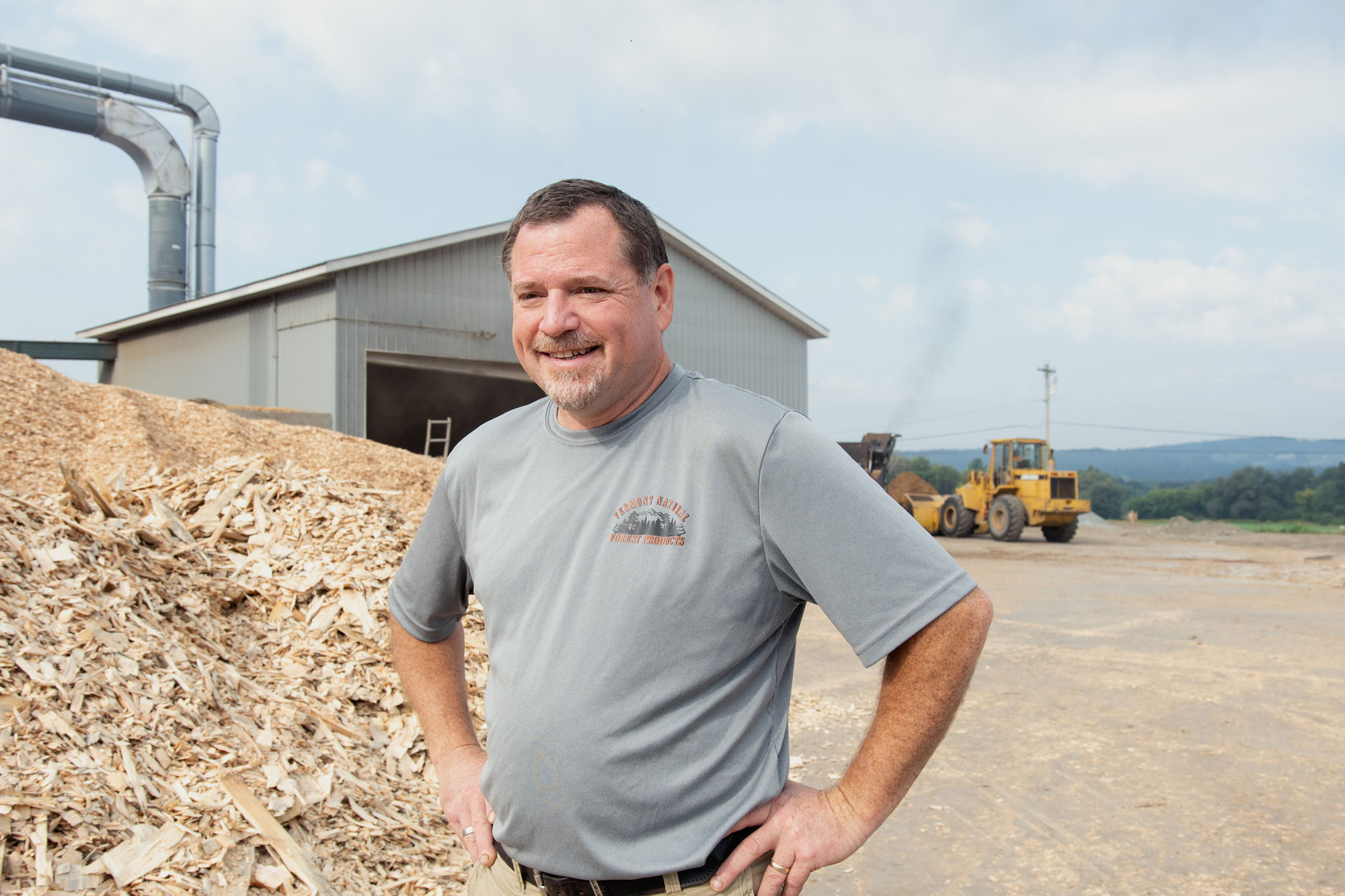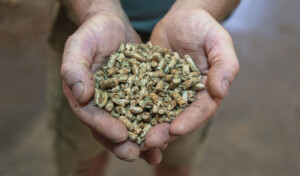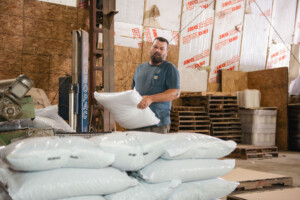Neighbor to Neighbor: Vermont Natural Forest Products Sees Potential in Pellets
October 30, 2023

An alternative to importing fuel for heat, Richford VT sawmill produces clean burning, locally sourced wood pellets.
Christine McGowan, Vermont Sustainable Jobs Fund
Efficiency is the lens through which Phil Gervais sees business. After 15 years working with multinational corporations around the world to find greater efficiency in infrastructure, computerization, and administration, Phil returned home to Enosburg, Vermont to help his son, Josh, and his business partner, Matt Gregoire, open Vermont Natural Forest Products.

Vermont Natural Forest Products is located at a former idle sawmill in Richford, Vermont. The founders saw an opportunity to draw on their logging and agriculture experience to process locally harvested, low-grade wood into animal bedding and sawdust for nearby farms. Photo by Erica Houskeeper.
“In terms of profitability, there is a narrow margin for error in the forest products sector,” said Phil. “We have to look at everything to find efficiencies.”
Josh Gervais and Matt Gregoire purchased an idle sawmill in Richford, Vermont in 2021. They saw an opportunity to draw on their logging and agriculture experience to process locally harvested, low-grade wood into animal bedding and sawdust for nearby farms.
“When a maple producer needs to clear their sugarbush, oftentimes those smaller diameter trees are left in the forest because the cost of trucking and processing outweighs the value of the finished product,” said Phil. “On the other hand, you have farmers buying sawdust and wood chips that have been trucked over 3 hours to get here. From an efficiency standpoint, there is a better way.”
Heavenly Economics
In their first year, the new owners focused on getting the plant up and running, fixing and updating machinery, hiring staff, and re-establishing relationships with local farmers. Josh, who owns two other local businesses, pulled in expertise where needed. Matt, a third generation logger, focused on harvesting and hauling wood from the surrounding forests.
The limitation, they found, was living in a rural part of an already rural state. There simply aren’t as many farms that need animal bedding as there is wood available to process. And, as they started trucking the chips further afield, the cost-benefit ratio began to dwindle.

The company estimates it could produce 30,000 to 40,000 tons of pellets a year given the mill capacity and readily available low-grade wood. That’s 100 times the amount of wood pellets they are producing now. Photo by Erica Houskeeper.
They decided to tune up an old wood pellet processor on the property and begin experimenting with production of wood pellets for heating. “It turns out the sawdust is the perfect precursor product to wood pellets,” said Phil. Within the first year, they had purchased a second pellet machine and were producing and selling 300 tons of wood pellets to their neighbors.
The addition of the wood pellets to the product mix meant they could purchase more low-grade wood from local loggers, and offer their neighbors a more price stable alternative to heating with fuel oil.
“Heating a home in Vermont is expensive,” said Phil. “On average, it’s 10 percent of a household budget and, with inflation, everything is 25 percent more expensive. When folks don’t have to rely on the fluctuating price of fuel oil, and instead can purchase a local, renewable product that keeps their dollars right here in our community, that’s a big thing.”
“Petroleum is a global product,” he said. “Wood is a local product.”
80 cents of every wood heat dollar stays in VT versus 22 cents of a fossil fuel dollar, according to a 2016 study. Clean burning, advanced wood heat, which includes wood pellets, has been identified as an important part of reaching 90 percent renewable energy in Vermont by 2050.
“When I see something that nobody wants, and I can make that into something that has value–both for the buyer, the seller, and the customer–and keep money in the local economy, that’s what I call ‘heavenly economics.’ Everybody wins,” said Phil.
Wood Pellet Potential
Phil estimates that they could produce 30,000 to 40,000 tons of pellets a year given the mill capacity and readily available low-grade wood. That’s 100 times the amount of wood pellets they are producing now. He points out that Vermont forests have a net growth ratio of 2:1, meaning that the number of trees is increasing at twice the rate they are harvested.

Anthony Ryea stacks bags of pellets at Vermont Natural Forest Products in Richford. Vermont Natural Wood Products provides every employee with free wood pellets, enough to heat their homes all winter. Photo by Erica Houskeeper.
What’s more, an independent study on the impact of using wood pellets on greenhouse gas emissions in the Northeast, found that using wood pellets for heat reduces greenhouse gas emissions by more than half compared to oil or propane. Over 50 years, greenhouse gas emissions from pellets are 62% less than oil, 67% less than natural gas, and 56% less than propane.
“It’s a triple bottom line decision,” said Emma Hanson, formerly Vermont’s Wood Energy Coordinator. “Heating with wood supports the local economy, moves Vermont towards its goal of meeting 90% of total energy needs from renewables by 2050, and it stabilizes heating costs.”
Anecdotally, Phil notes that Vermont’s aging population is tired of splitting, stacking, and storing cord wood. “What we need,” he says, “is a wood pellet industry that is as easy to use as fuel oil.” There are already options in Vermont for having pellets delivered to a “hopper,” but many who use pellets for heat are purchasing and storing the pellets in 40-pound bags. Vermont Natural Forest Products is in talks with furnace manufacturers about how to make purchasing, storing, and burning wood pellets as convenient and efficient as possible.
Local Wood, Local Labor
In the meantime, Vermont Natural Forest Products provides every employee with free wood pellets, enough to heat their homes all winter.
“That’s a 10% decrease in household expenses,” said Phil, “and our employees feel like they are part of something. We have a really high level of employee satisfaction because we all know we’re doing something that benefits our community.”
It doesn’t hurt, he adds, that many of the young people working at the mill come from multi-generational forestry and agriculture families in the area and want to keep those connections. “If we weren’t providing these jobs, some of these folks would be driving to Burlington or Essex every day for work.”
“You can look at a town like Richford where there has been zero population growth for 30 years and think, why?,” said Phil. “We’re meant to be here. Are we not working hard enough? No, It’s that the money doesn’t stay here. We have to change the formula and support local businesses.”
For more information: feelgoodheat.org, vermontnaturalforestproducts.com.
About the Vermont Forest Products Program at VSJF
Vermont’s forest economy contributes more than $2 billion in direct economic output and provides more than 13,000 jobs in forestry, logging, processing, specialty woodworking, construction, wood heating, maple production, and forest-based recreation. The Forest Products Program at the Vermont Sustainable Jobs Fund (VSJF) creates space for strong relationships and collaboration throughout the industry and promotes the development of new and existing markets for Vermont wood products. Committed to nurturing the sustainable development of Vermont’s economy, VSJF provides business assistance, network development, strategic planning, and value chain facilitation in agriculture and food system, forest products, waste management, renewable energy, and environmental technology sectors. Learn more at www.vsjf.org.




